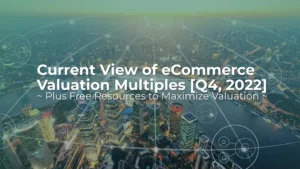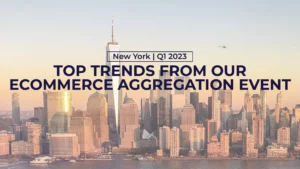Read Time: 3 minutes
If you are an eCommerce entrepreneur considering an exit in the near-term, understanding the factors that impact the value of your business allows you to:
- Accurately evaluate your business.
- Best time your exit.
- Attract the right buyer: Each buying firm has a specific acquisition criteria. To pitch to the right firm you need to understand the valuation of your business.
- Aggressively negotiate the best offer (SDE/EBITDA multiple) within the bounds of the market.
- Close the deal.
In this post, we will look at six factors that drive eCommerce valuations.
These insights were taken from our quarterly eCommerce Valuation Report. Contact us at exits@thefortiagroup.com to request the full report.
1. Global M&A Activity
There is a correlation between global deal activity and eCommerce M&A activity. Global volumes decreased in 2022 and Q1 2023 vs. Q4 2022. However, volume increased each month in Q1 2023. The outlook is positive, 62% of private equity professionals believe M&A activity will increase in 2023 vs. 2022.
2. eCommerce Trends
It has been a difficult period for the eCommerce sector which is reflected in the price performance of listed comparables. However, there are positives. For example, the post Covid hangover is complete implying that comparables are more favorable and declining freight costs will improve margins.
3. Public Market Comparables
eCommerce indices, DTC IPOs and DTC stocks have all declined significantly over the last 12 months. This is a difficult backdrop for valuations of unlisted eCommerce brands. For additional context, the revenue multiples of the 5 listed eCommerce brand aggregators ranges from 0.31x to 1.48x revenue.
4. eCommerce M&A Activity
The peak of eCommerce deals and valuations was 2021. H2 2022 was quiet. However, there is increasing dealflow in 2023.
Three examples: i) the $26m acquisition of Belami eCommerce by SKYX for 6x EBITDA; ii) Victoria’s Secret $400m acquisition of Adore Me; and iii) the acquisition by an aggregator of Jayflex Fitness.
5. Brand Metrics
Entrepreneurs have control over how they run their brand and the resulting metrics. The top financial metrics acquirors analyze when considering valuation are revenue, revenue growth, gross margin, net margin and trajectory of net margins. There are several operational metrics that vary from Direct-to-Consumer [DTC] and Fulfillment-by-Amazon [FBA] led brands.
6. Deal Dynamics
There are several dynamics that can influence valuation e.g. capital markets and aggregator funding, quantum of dry powder available to private equity, the specific situation of seller or acquiror, quality of advisor, deal marketing and distribution strategy, synergies, deal structure and valuation expectations of seller.
Valuation
Valuations declined in 2022 due to factors outside the control of entrepreneurs (1-4 above). Today the typical range for a performing FBA led brand is 2x-4.5x SDE and 2x-10x EBITDA for DTC led brand. The valuation a brand gets within the range depends on how it scores in two areas (5, 6 above). Diamonds price above these ranges.
Note: Multiples include up-front and deferred consideration but exclude inventory.
Partner With The Fortia Group
As an Investment Bank that focuses specifically on the eCommerce lower and middle market, The Fortia Group differs from other firms and secures the best deal by:
- Offering an Exit Ready programme to prepare your business to go to market, even 1 –3 years out.
- Running a competitive auction with all the relevant buyers including PE firms, family offices and strategics to achieve the best valuation.
If you are an eCommerce entrepreneur seeking to maximize your exit in 2023 or 2024, contact us today to explore the best exit strategy for you.







